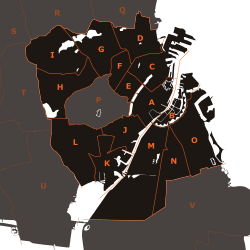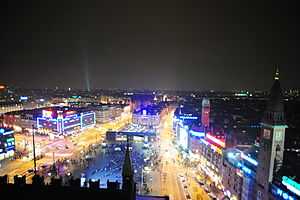Copenhagen Municipality
| Copenhagen Municipality Københavns Kommune | |
|---|---|
| City of Copenhagen | |
|
Copenhagen Skyline | |
| Anthem: m | |
|
| |
 A: Indre By ("Copenhagen Center"), B: Christianshavn, C: Indre Østerbro ("Inner Østerbro"), D: Ydre Østerbro ("Outer Østerbro"), E: Indre Nørrebro ("Inner Nørrebro"), F: Ydre Nørrebro ("Outer Nørrebro"), G: Bispebjerg, H: Vanløse, I: Brønshøj-Husum, J: Vesterbro, K: Kongens Enghave, L: Valby, M: Vestamager, N: Sundbyvester, O: Sundbyøster | |
 Copenhagen | |
| Coordinates: 55°40′31″N 12°34′13″E / 55.67528°N 12.57028°ECoordinates: 55°40′31″N 12°34′13″E / 55.67528°N 12.57028°E | |
| Country | Denmark |
| Seat | Copenhagen City Hall |
| Districts | |
| Government | |
| • Type | Council |
| • Body | Copenhagen City Council |
| • Lord Mayor | Frank Jensen (Socialdemokraterne) |
| Area | |
| • Total | 77.2 km2 (29.8 sq mi) |
| Highest elevation | 91 m (299 ft) |
| Lowest elevation | 0 m (0 ft) |
| Population (1 January 2015)[1] | |
| • Total | 580,184 |
| • Density | 7,500/km2 (19,000/sq mi) |
| Time zone | CET (UTC+1) |
| • Summer (DST) | CEST (UTC+2) |
| Postal code | 1000-2300 |
| Municipal code | 101 |
Copenhagen Municipality (Danish: Københavns Kommune) is the largest of the municipalities making up the city of Copenhagen. It lies at the center of Copenhagen and contains the old historic city.
The municipality covers 90.47 km² (2013) according to Municipal Key Figures (Danish: De Kommunale Nøgletal (www.noegletal.dk)) from the Ministry of Economy and Interior and it has a population of 580 184 ( 1 January 2015 ).
The Lord Mayor of Copenhagen (equivalent to the Mayor of London rather than the Lord Mayor of the City of London), is the head of the largest party elected at municipality elections held regularly in fixed years every fourth year on the third Tuesday of November in accordance with the municipal elections law, the latest held on Tuesday 19 November 2013.
Since 1 January 2010 Lord Mayor of Copenhagen is Frank Jensen, a member of the Social Democrats (Socialdemokraterne) political party. The Lord Mayor acts as the head of the Finance Committee. His party remained the largest after the Municipality election in November 2013, which chose the 55 members for the four-year term 2014-2017. Other mayors are Morten Kabell (Technics and Environment Committee), Carl Christian Ebbesen (Cultural and Recreational Committee), Pia Allerslev (Children and Youth Committee), Ninna Thomsen (Health and Care Committee), Jesper Christensen (Social Committee) and Anna Mee Allerslev (Employment and Integration Committee).
The municipal seat of government is the Copenhagen City Hall (Danish: Københavns Rådhus).
Overview
Copenhagen municipality was one of the three last Danish municipalities not belonging to a county — the others being Frederiksberg (the municipality with the smallest area and an enclave within Copenhagen municipality itself) and Bornholm. On 1 January 2007, the municipality lost its county privileges and became part of Region Hovedstaden (i.e. the Copenhagen Capital Region).
Neighboring municipalities are Gentofte, Gladsaxe and Herlev to the north, Rødovre and Hvidovre to the west, and Tårnby to the south. Frederiksberg is located as an enclave within the municipality, and is thus surrounded by Copenhagen.
Copenhagen municipality was not merged with other municipalities on 1 January 2007 as the result of nationwide Kommunalreformen ("The Municipal Reform" of 2007).
Districts
The municipality is divided into 10 (formerly until 2007: 15) administrative, statistical and tax districts (Danish: bydele).:[2]

| Official districts[2] | Other areas |
|---|---|
|
Former division:
|
|
Demography
Historic population. The two figures for 1 February 1901 are before and after the municipality annexed some nearby parishes. The apparent decline since the mid-1900s are due to the figures not including the suburban and urban areas - notably Frederiksberg - outside Copenhagen municipality.
|
|
|
Note. The two population numbers given for 1901 are the municipality's population before annexation and following annexation of neighboring municipalities, which in the process made Frederiksberg municipality an enclave within the municipality of Copenhagen.
Politics and government
The Copenhagen municipality is governed by Copenhagen's municipal council (Danish: Borgerrepræsentation). Council elections are held the third Tuesday of November every four years. The latest were held Tuesday 19 November 2013, when politicians were elected for the fouryear term of office 2014 - 2017. Following the 2013 municipal elections, the 55 seats are divided in the following way (with the 2009 election results in parenthesis):
- The Socialdemocrats 15 (17)
- Socialist People's Party 6 (13)
- The Red-Green Alliance 11 (6)
- Social Liberal Party (Det Radikale Venstre) 7 (5)
- Liberal party (Venstre) 7 (6)
- Conservative People's Party 3 (4)
- The Danish People's Party 4 (4)
- Liberal Alliance (Denmark) 2 (0)
The political leader/mayor of the Copenhagen municipality has since 1903 been a Social Democrat.
Environmental Policy
In 2009 the Copenhagen Municipal Council decided that Copenhagen will become the world's first carbon neutral capital by 2025. In 2012 the European Commission announced that Copenhagen will be the 2014 European Green Capital.
References
- ↑ FOLK1: Population 1 October 2012 database from Statistics Denmark (Danish)
- ↑ 2.0 2.1 "Københavns bydele". Københavns Kommune. Retrieved 31 December 2012.
External links
- Official website
- CPH International Service - Citizen service for expats and students in Copenhagen
- Eniro map with named municipalities (Danish)
- Krak searchable/printable map (Danish)
| |||||||||||||||||||||||||||||

